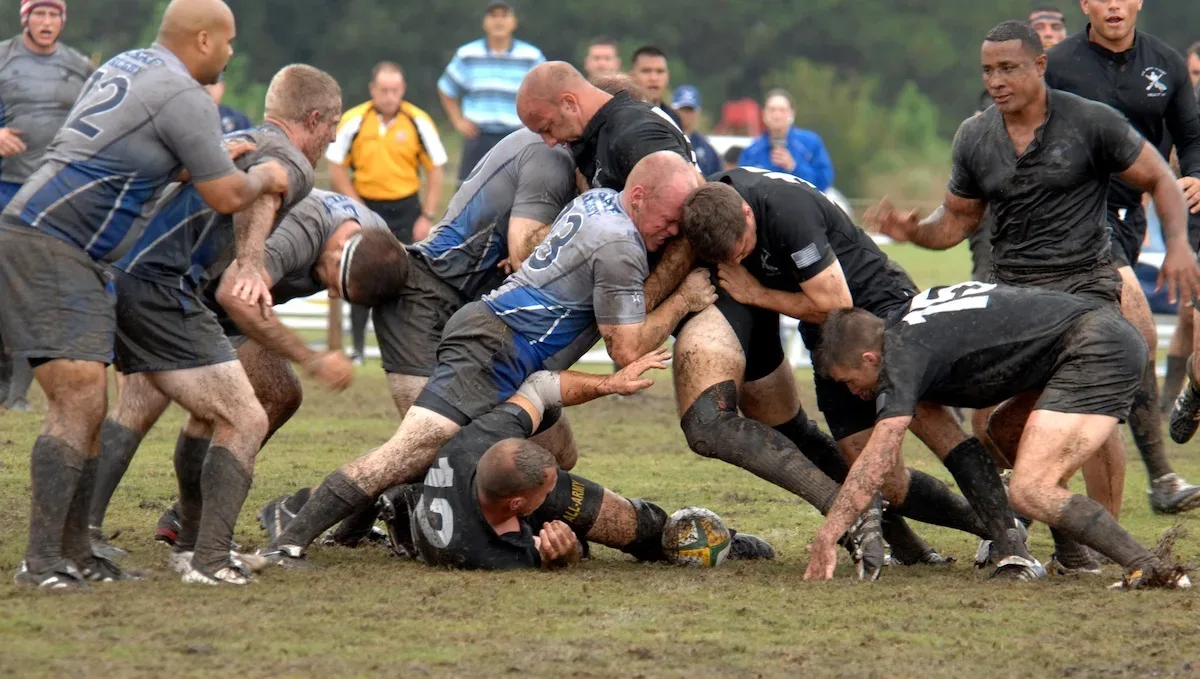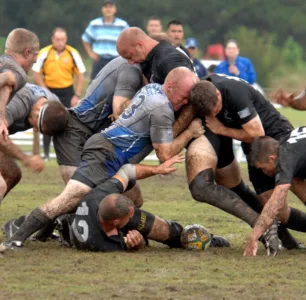Introduction
In the high-octane world of rugby, the ruck is a battleground where possession and momentum can shift in an instant. Among the most crucial skills a player can possess is the art of “jackaling.” This term refers to the ability to win the ball back for your team when they are on defense. In this article, we will delve into the intricacies of jackaling, exploring the rules that govern it, the techniques employed by players, and the essential skills required to execute it effectively. Whether you’re a seasoned rugby player looking to refine your jackaling prowess or a newcomer eager to understand the mechanics of this thrilling aspect of the game, this guide has got you covered.
I. The Ruck and the Jackal
Before we dive into the details of jackaling, let’s briefly revisit what a ruck is and its significance in rugby. A ruck occurs when one or more players from each team, on their feet, close around the ball, which is on the ground following a tackle. The ruck marks the contest for possession, and it is in this very situation that the jackal emerges.
The jackal is a player, usually a loose forward or a flanker, who positions themselves over the tackled player and the ball, attempting to secure it for their team. To be a successful jackal, players must possess a combination of agility, strength, and, most importantly, an innate understanding of the laws governing the ruck.
II. The Rules of Jackaling
Jackaling is an art that must be executed with precision to avoid penalties and maintain a fair contest. Let’s explore the key rules that players must adhere to when competing for the ball in a ruck:
a. On Your Feet
For a player to legally contest the ball, they must be on their feet. This means they cannot dive or flop on the ground immediately after a tackle to try to reach the ball. Instead, they must approach the ruck from behind the hindmost foot of their teammate who is also over the ball.
b. Hands Off
Players contesting for the ball must use their hands to pick it up, not their feet. Kicking the ball out from beneath the player in possession is not allowed and will result in a penalty.
c. Entry Point
The jackal must enter the ruck through the “gate.” The gate is an imaginary line formed when the last feet of the tackled player and the first arriving player on their team are on the ground. The jackal must approach the ball from behind this gate.
d. Retaining Balance
A jackal must maintain balance and support their body weight when contesting for the ball. Players cannot intentionally collapse the ruck to disrupt the opponent’s possession.
e. Hands on the Ball
Once the jackal is over the ball, they must have their hands on it to secure possession legally. A player cannot simply lie over the ball without attempting to gather it.
III. Essential Skills for Jackaling
Executing a successful jackal requires a combination of technical proficiency and tactical awareness. Here are some of the key skills that players must develop to become proficient jackalers:
a. Body Positioning
Getting into the correct body position is paramount when contesting for the ball. Players should crouch low with their hips lower than their shoulders, providing a stable and powerful base. This low body position allows for better balance and helps withstand counter-rucking attempts from the opposition.
b. Hand-Eye Coordination
Winning the ball in a ruck demands exceptional hand-eye coordination. A jackaler must be able to spot the ball quickly, react swiftly, and use their hands to secure it while under immense pressure.
c. Core Strength and Stability
Jackaling is a physical battle, and having a strong core is crucial for maintaining stability over the ball. It helps players resist being driven off the ball by the opposition and allows them to stay in a strong body position throughout the contest.
d. Timing and Decision-Making
Knowing when to contest for the ball is just as important as knowing how to do it. Players must make split-second decisions based on the dynamics of the ruck, the defensive strategy, and the positioning of their teammates and opponents.
e. Communication
Effective communication is essential in rugby, and jackaling is no exception. Players must communicate with their teammates to coordinate their efforts in the ruck, whether it’s to secure possession or to execute a strategic turnover play.
IV. Mastering Jackaling Techniques
To become a proficient jackaler, players must hone specific techniques to enhance their chances of winning turnovers. Here are some of the key techniques employed by players:
a. The “Fetch”
The “fetch” is a technique used by jackalers to quickly retrieve the ball as soon as the tackle is made. It requires the jackal to time their entry into the ruck expertly. As the ball carrier is tackled, the jackal must swiftly pounce on the ball and secure it before the opposition can react.
b. The “Seal”
The “seal” is a technique used to protect the ball and maintain possession for the attacking team. When a player from the attacking team goes to the ground with the ball, the jackal must position themselves between the tackled player and the ball to create a barrier for the opposition. The goal is to shield the ball and prevent the opponent from reaching it, buying valuable time for support to arrive.
c. The “Counter-Ruck”
While jackaling is primarily about winning the ball for your team, players can also employ a “counter-ruck” technique to disrupt the opposition’s possession. The counter-ruck involves driving into the ruck with force, aiming to dislodge the ball or force a turnover.
d. The “Drag”
The “drag” is a technique used by a jackaler when they cannot cleanly pick up the ball with their hands. In this move, the player uses their foot to hook or drag the ball backward, allowing a teammate to secure possession or continue the attack.
V. Tactical Considerations for Jackaling
Jackaling is not a one-size-fits-all approach; it requires adaptability and a deep understanding of the game’s ebb and flow. Here are some tactical considerations that players must take into account when attempting to win turnovers:
a. Assessing the Situation
Before committing to a jackal, players must assess the ruck’s dynamics. Factors such as the number of opponents committed to the ruck, the presence of support players, and the attacking team’s positioning will all influence whether it’s a suitable opportunity to contest for the ball.
b. Knowing When to Pull Out
Jackaling carries an inherent risk. If a player commits to a jackal but realizes they don’t have a realistic chance of securing the ball, they must be prepared to disengage and get back into the defensive line quickly. Holding on in such situations risks conceding penalties or exposing the defense.
c. Playing to Strengths
Different players have different strengths, and this applies to jackaling as well. Some players may excel at the fetch, while others may be better suited for counter-rucking or sealing. Coaches and players must identify and leverage each player’s individual abilities when devising a jackaling strategy.
d. Communication and Support
Jackaling is not a solo endeavor. Effective communication with teammates is vital to coordinate efforts and execute successful turnovers. Players must signal their intentions and receive feedback from their teammates to make split-second decisions during the heat of the battle.
e. Maintaining Discipline
Jackaling can be an intense and emotional aspect of the game, but players must maintain discipline and composure. Engaging in illegal or reckless actions in the ruck can lead to penalties, yellow cards, and significant advantages for the opposing team.
VI. Training and Drills for Jackaling
To become a proficient jackaler, players need to dedicate time and effort to training specific skills and techniques. Coaches can design various drills to simulate game scenarios and help players develop their jackaling abilities. Here are some training drills that can enhance a player’s jackaling prowess:
a. The Ruck Relay
This drill involves setting up a series of small rucks in a straight line. Players take turns jackaling over each ruck and quickly moving to the next. The drill helps players work on their speed, accuracy, and decision-making in a high-intensity environment.
b. The Fetch and Secure
In this drill, a coach or teammate simulates a tackled ball carrier, and the jackaler must rush in to secure the ball before an opponent “competes” for it. The focus here is on timing, body positioning, and quick hands.
c. The Counter-Ruck Challenge
In this drill, players form two teams with an attacking team and a defensive team. The attacking team tries to maintain possession, while the defensive team attempts to counter-ruck and win the ball back. This drill emphasizes the importance of physicality and teamwork in the ruck.
d. The Decision-Making Game
This drill focuses on honing a player’s ability to make quick decisions in the ruck. A coach calls out different scenarios (e.g., “fetch,” “seal,” “counter-ruck”) as players engage in a ruck, and the jackaler must react accordingly. This drill sharpens a player’s tactical acumen.
e. Live Scrimmaging
Nothing can truly replicate the pressure and intensity of a live match. Incorporating jackaling opportunities into regular scrimmage sessions allows players to apply their training in a real-game context and refine their skills under game-like conditions.
VII. Jackaling Success Stories
Throughout rugby history, there have been players who have mastered the art of jackaling and left an indelible mark on the sport. Let’s take a look at some iconic jackalers and how their skills have influenced the game:
a. Richie McCaw
Widely regarded as one of the greatest rugby players of all time, Richie McCaw was a maestro at the breakdown. The New Zealand openside flanker’s ability to win crucial turnovers and slow down opposition ball was unparalleled. His presence at the ruck was a constant headache for opposing teams, and his leadership in this area was pivotal in the All Blacks’ success during his career.
b. David Pocock
The Australian flanker, David Pocock, was another jackaling sensation. Renowned for his incredible work rate and tenacity, Pocock’s presence at the breakdown made him a significant threat to opposition teams. His ability to win turnovers consistently and disrupt the flow of the game earned him accolades from fans and fellow players alike.
c. Sam Warburton
As the former captain of Wales and the British and Irish Lions, Sam Warburton was a key figure in the art of jackaling. His exceptional technique and timing at the breakdown allowed him to secure vital turnovers for his teams. Warburton’s leadership and proficiency as a jackaler earned him the admiration of fans worldwide.
d. Michael Hooper
The Australian openside flanker, Michael Hooper, is known for his incredible endurance and work ethic. His relentless pursuit of the ball and uncanny ability to win turnovers have made him a standout jackaler in the modern game.
VIII. Conclusion
Jackaling is a pivotal aspect of rugby, where possession and momentum can change hands with lightning speed. From understanding the rules that govern the ruck to developing the essential skills and mastering the various techniques, becoming a proficient jackaler requires dedication, discipline, and tactical awareness. As we’ve seen through the success stories of rugby legends like Richie McCaw, David Pocock, Sam Warburton, and Michael Hooper, mastering the art of jackaling can elevate a player’s impact on the game and contribute significantly to the team’s success.
For aspiring rugby players and seasoned veterans alike, the journey to becoming a formidable jackaler is an exhilarating one. It demands continuous improvement, relentless practice, and a thirst for knowledge. So, whether you find yourself at the heart of the action in the ruck or marveling at the incredible skills of the jackalers on the field, one thing is for certain – the art of jackaling will forever remain a captivating and indispensable part of the sport we all love: rugby.

